|
A Brief History of Penderlea Homestead Farms, Inc.
Penderlea Homestead Farms, located in northwest Pender County, North Carolina, was the first of 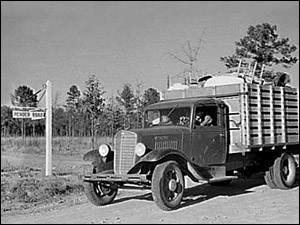 152 homestead projects developed in 1934 under President Franklin Roosevelt's New Deal. The purpose of the homestead projects was to provide penniless tenant farmers, bankrupt farm owners, and unemployed ex-farmers during the Great Depression with a means of making a living. Providing for self-sufficient rural communities also eased the burden of over-crowded cities. 152 homestead projects developed in 1934 under President Franklin Roosevelt's New Deal. The purpose of the homestead projects was to provide penniless tenant farmers, bankrupt farm owners, and unemployed ex-farmers during the Great Depression with a means of making a living. Providing for self-sufficient rural communities also eased the burden of over-crowded cities.
1934: Hugh MacRae's Farm City
In 1934, Hugh MacRae, prominent Wilmington developer and agriculturist, proposed to the Division of Subsistence Homesteads, U.S. Department of the Interior, that a homestead project be established in Pender County. The Division sent experts to investigate the land for its suitability and found the soil perfect for truck crops. MacRae sold 4,700 acres of cut-over woodland to the Government at a cost of $6.50 per acre and, subsequently, he became the first manager of Penderlea Homestead Farms, Inc.
Penderlea was not the first of MacRae's farm colonies. The entrepreneur had previously developed Castle Hayne, St. Helena, and Van Eeden, the latter two with limited success. But Penderlea Homesteads, designed by a prominent city planner from Boston, John Nolen, was different. The basic plan was to build a farm city and recruit 300 people to live in a community of 10-acre cooperative truck farms with a central marketing plant. MacRae staunchly believed that 10-acre farms were sufficient to provide homesteaders subsistence and a cash income to purchase homesteads under a lend-lease arrangement.
Penderlea Homestead Farms was laid out in horseshoe fashion around a central community center 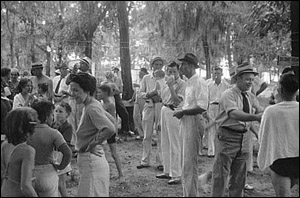 which included a 23-acre school campus with an auditorium, gymnasium, cafeteria, library, shop building, home economics building and teacherage. In addition to the school and family farms, plans for the project included a vegetable grading shed, potato storage house, a cannery, grist and feed mills, a general store, social building, and furniture factory. Three hard-surfaced roads connected Penderlea to the surrounding towns of Wallace, Burgaw and Watha where railway stations awaited shipments of produce to the north and south. which included a 23-acre school campus with an auditorium, gymnasium, cafeteria, library, shop building, home economics building and teacherage. In addition to the school and family farms, plans for the project included a vegetable grading shed, potato storage house, a cannery, grist and feed mills, a general store, social building, and furniture factory. Three hard-surfaced roads connected Penderlea to the surrounding towns of Wallace, Burgaw and Watha where railway stations awaited shipments of produce to the north and south.
Most of the small ten-acre plots in Penderlea faced on a road in front and a forest belt or creek or ditch in the rear. A homestead consisted of a modern house equipped with electricity and running water, a barn, poultry house, A-type hog house, corn crib, and a combination wash and smoke house. Homes ranged in size from 4 to 6 rooms, depending on the size of the family. Individual water supply was provided by an electric pump with storage tanks for hot and cold water. Houses were mounted on brick tiers and featured exterior siding of white creosoted cedar shingles with green shutters. The interiors featured walls of tongue and groove pine boards and Celotex ceilings. The flooring consisted of scraped and oiled pine, except for the first ten of the original houses which had oak floors in the living room.
Hugh MacRae personally directed the Penderlea project only until May 1934 at which time the 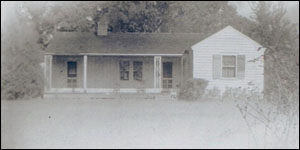 Division of Subsistence Homesteads projects were federalized. At that time only 1500 acres had been cleared and 10 houses built. A new farm management study initiated by the Division indicated the insufficiency of the 10-acre farms and plans for Penderlea were completely revised with new plans calling for 150 homesteads of 20 acres each. Division of Subsistence Homesteads projects were federalized. At that time only 1500 acres had been cleared and 10 houses built. A new farm management study initiated by the Division indicated the insufficiency of the 10-acre farms and plans for Penderlea were completely revised with new plans calling for 150 homesteads of 20 acres each.
1935
In May of1935, the Resettlement Administration inherited the Penderlea project and with the help of nearly 2000 relief workers, completed 142 homesteads, including drilling wells and building pump houses, barns, hog houses, and chicken houses.
1936 - 1937
With the exception of 4 or 5 early homesteaders in the homes completed by MacRae, the first group of homesteaders moved into Penderlea in the fall of 1936. Homesteaders were chosen from rehabilitation clients and submarginal farmers who had to be approved by their county agents and submit to a medical examination before occupancy. They were furnished with livestock, seed, feed, fertilizer, and subsistence, for all of which they executed personal notes.
In 1936, the Resettlement Administration was placed under the Department of Agriculture and 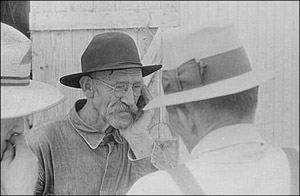 Penderlea, along with other projects was then shifted to the Farm Security Administration. In March options were secured on an adjoining 6,000 acres designated as the Penderlea Extension, enlarging the project to 9,833 acres. Plans called for another 158 homesteads of 30 acres each. Penderlea, along with other projects was then shifted to the Farm Security Administration. In March options were secured on an adjoining 6,000 acres designated as the Penderlea Extension, enlarging the project to 9,833 acres. Plans called for another 158 homesteads of 30 acres each.
In the meantime, the highlight of Nolen's community center, the large 31 room consolidated school with its community library, craft, music and band rooms, an auditorium, a large gymnasium, social and home economics building, shop and a school bus garage were completed. Also in the community center were the administration building, a health clinic, a home for teachers, a potato curing house, a cane-syrup mill, a cannery, a co-ooperative store, a large warehouse, a gristmill, a grading house and a furniture shop that provided furniture for the Penderlea homes.
Only 112 families were occupying the 142 completed homesteads by January 1937. The remaining houses filled very slowly with 17 houses still vacant in September. Confusion abounded over the variable-payment, trial-type leases and closely supervised farm and home plans. Loans were furnished only through a joint bank account with the project manager. In June 1937, the Resettlement Administration initiated several cooperative enterprises, including a loan of $30, 670 to the Penderlea Mutual Association to form a stock company under North Carolina law to operate the grist mill, store, cane-syrup mill, the community cannery and a filling station.
Enthusiasm for the Penderlea project was high in Washington. On August 7, 1937, 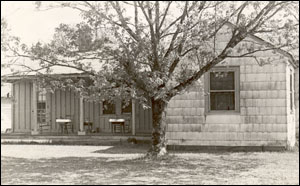 Penderlea homesteaders received a visit by First Lady, Eleanor Roosevelt, who delighted her audience by dancing with many of the men. A well-rehearsed pageant was written and performed by the homesteaders for Mrs. Roosevelt, Governor Erhinghause and many other dignitaries who came to see the Penderlea Homestead Farms. Penderlea homesteaders received a visit by First Lady, Eleanor Roosevelt, who delighted her audience by dancing with many of the men. A well-rehearsed pageant was written and performed by the homesteaders for Mrs. Roosevelt, Governor Erhinghause and many other dignitaries who came to see the Penderlea Homestead Farms.
In September, 1937, the Farm Security Administration was created and the Farm Tenant Act was put into place to allow tenants to purchase their farms, but the government still had no plan in effect to enable Penderlea homesteaders to buy their farms. Also, there was growing dissatisfaction with growing truck crops when cash crops like tobacco had been such a large part of their previous farming experience.
1938
Most of the community construction was completed by 1938, but only 50 of the extra homes were ever completed. Many of the homesteaders had depended on construction work as their only source of income. Some of the farmers who had learned skilled trades, hired others to work their farms, but when construction ended, farming became their only recourse.
In September, 1938, the news that Penderlea was selected as one of only five hosiery mill sites in the United States to be financed by the Farm Security Administration was received as a godsend. With a loan of $750,000, the Penderlea Homesteads Association built a hosiery mill that was owned entirely by the homeowners, who hired Dexdale Hosiery Company as a non-profit managing company to operate it.
1939
By 1939, the hosiery mill was in full operation, employing men, women and children in the manufacture of silk hosiery. But a change was coming and soon the plant would be spinning nylon for parachutes. Germany had invaded Poland. Britain and France had declared war on Germany while Roosevelt was maintaining a position of neutrality. With the United States economy booming with orders for arms from European countries, many of Penderlea's farmers took on jobs in Wilmington's shipyards and in other industries that paid higher wages than they'd ever seen before.
1940's
It was not until the FSA was abolished and Penderlea was transferred to the newly created Farmers Home Administration (FHA) that homesteaders finally got the right to purchase their farms from the Government through a deed-mortgage arrangement. The Federal government withdrew from Penderlea after the FSA consolidated the project into 105 farm units of 40 to 125 acres each. The consolidated farms sold for an average of $3,020. About 50 houses were sold and moved off the project to make the larger farms. In September, 1947, the government hired an auctioneer to auction off the remaining 3,800 acres of farm and timberland and seventy-seven farms with dwellings and outbuildings.
The hosiery mill was sold to Dexdale Hosiery Mill, who in 1949 sold it to Concentrate Manufacturing Company, a processing and packaging company for Roger and Gallet, a French cosmetics firm. By 1950, Penderlea was no longer a homestead cooperative project but a community of independent farmers who were buying their farms. Today, of the 300 homes built on Penderlea, only about 99 remain.
This information was compiled from a variety of sources, primarily,
Conkin, Paul Keith: Tomorrow A New World. Ithaca, N.Y.: Cornell University Press, 1959
Cottle, Ann Southerland: The Roots of Penderlea: A Memory of a New Deal Homestead Community. Wilmington, NC: The Publishing Laboratory, Department of Creative Writing, University of NC Wilmington. 2006. For more information: 910-285-3490.
New Hanover Public Library, 201 Chestnut Street, Wilmington, NC: Wilmington Morning Star Newspaper, Bill Reaves Collection (See Penderlea and Hugh MacRae folders).
|